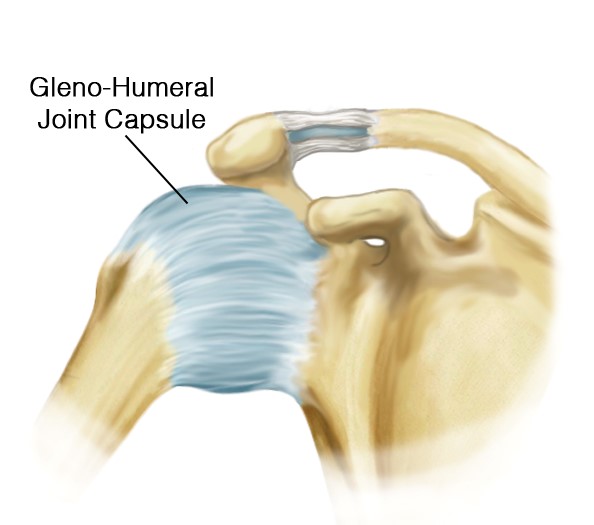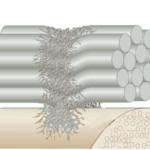Can a Massage Therapist Fix a Frozen Shoulder in Cambridge, MA
July 1, 2024

Question: Does a frozen shoulder always go away with time?
Answer: Often no.
The Causes of Frozen Shoulder

A frozen shoulder can be incredibly painful. The pain originates in the shoulder joint. A joint is formed where any two bones meet. It’s the enclosed space between your upper arm bone, the humerus, which is round, and the receiving bone, which is a circular cavity that it fits into. The joint is then wrapped in a fibrous capsule like a ball with a membrane inside of it.
In a frozen shoulder, the inside of the capsule develops adhesions that restrict movement. When you try to move in certain directions, it stretches and starts to tear. Your body gives you intense pain, which signals you not to make that motion again, and the muscles of the shoulder muscles quickly contract to prevent you from hurting yourself further. This is called protective muscle guarding.

The pain gradually increases over the course of a few months. It’s hard to lie on your side in bed; reaching to the side becomes impossible, and putting on a shirt or a coat becomes increasingly painful. Everyday activities like cooking, lifting, and reaching become more difficult.
Frozen shoulders are common, especially in women over 40. We don’t really know why, but it might be related to hormonal changes. The normal cycle without treatment is 9-12 months and occurs in three phases.
Phases of a Frozen Shoulder
The first three to four months are referred to as the freezing phase because the pain gets worse and worse. At first, it’s hard to brush your hair, then getting dressed is an ordeal. As the month progresses, it’s painful to scratch your nose or reach behind you. Then it’s impossible to sleep on that side at night. In the first three months, lifting a pot of water or cooking becomes more and more painful.
In the second three to four-month phase, the pain remains the same, and you are relieved that it has stopped getting worse. You still can’t do a lot of things, but at least you know what to expect; the situation has stabilized.
In the final three to four months, the pain slowly begins to recede. You begin to feel hopeful that this awful pain might disappear. and your limited flexibility may get better.
Can a Massage Therapist Fix a Frozen Shoulder
All adhesions inside the shoulder joint must be eliminated to recover from a frozen shoulder fully. Sometimes, this happens naturally over the course of the three phases. But for many people, a low level of pain remains, and it is difficult to reach full up or behind you. This means that some of the scar tissue adhesions are still there, and this leaves you vulnerable to a recurrence of severe pain.
With an accurate assessment and the proper treatment, almost everyone can fully recover. If a frozen shoulder has been successfully treated, the protective muscle guarding subsides and disappears naturally because it is no longer needed.
The treatment consists of two equally important parts. First, a physician injects an anti-inflammatory medication. Second, a skilled therapist performs intensive resisted stretching in multiple directions within a few hours of the injection. This specialized stretching with resistance is done twice a week for about a month. This special kind of stretching breaks up all the remaining adhesive scarring in the shoulder joint.
To be fully recovered, the person must be able to move in all these four directions I am demonstrating without any pain or limitation.




Within a week, at least 50% of the pain is usually gone, and within a month, usually all the pain is gone. The most important thing to prevent a recurrence is to fully restore the person’s movement.
If you are experiencing shoulder pain and live in the Boston area, schedule an appointment or a complimentary 10-15 minute phone consultation.
Schedule an Appointment or Call →
Ben E. Benjamin holds a Ph.D. in Sports Medicine and was the founder and President of the Muscular Therapy Institute in Cambridge, Massachusetts. He is the author of dozens of articles on working with injuries and chronic pain as well as the widely used books in the field, Are You Tense? Exercise Without Injury and Listen To Your Pain: The Active Person’s Guide to Understanding, Identifying and Treating Pain and Injury. Dr. Benjamin has been in private practice for over 50 years and teaches therapists throughout the country.
Related Posts

Why Does My Old Injury Still Hurt?
Question: What is the common denominator of chronic pain?
Answer: ADHESIVE SCAR TISSUE

Can Massage Help Pain that Travels? Cambridge MA
Question: Why does an injury to the neck cause pain that travels to the arm and hand? Answer: Referred Pain Pain that travels in your body is called Referred Pain. This phenomenon means the injury is in one place, and the pain is in another. Understanding this phenomenon helps you better understand your body’s responses […]

Can Massage Therapy Help Lower Back Pain Cambridge, MA?
Lower back pain is experienced by at least 50 million people each year in the United States alone. My own severe back pain when I was a teenager is what led me into this field. Back pain is often a debilitating, terrible experience. But it can also be annoying and limiting. I’ve treated hundreds of […]

Massage Therapy for Chronic Neck Pain Near Cambridge, MA
Question: What’s the most common cause of chronic neck pain? Answer: Ligament sprains The Causes of Pain in Your Neck For many reasons, your neck can be painful, but most people are unaware of the most common cause of chronic neck pain. Sprained or severely injured muscles can cause pain in the neck, but muscles […]

Can Massage Therapy Help Hamstring Pain Near Cambridge, MA
Question: Do you think a similar pain in the back of the thigh while running can be attributed to a hamstring injury or a lower back injury? True or False? Answer: True Hamstring Anatomy You have three hamstring muscles in the back of your thigh. Every muscle has a tendon that attaches it to […]
